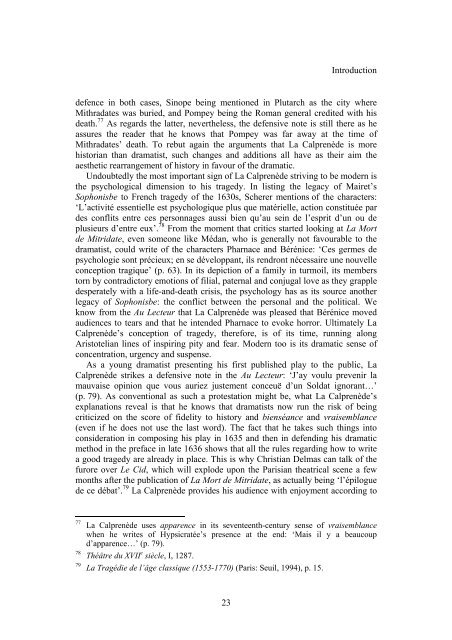LA MORT DE MITRIDATE - University of Liverpool
LA MORT DE MITRIDATE - University of Liverpool
LA MORT DE MITRIDATE - University of Liverpool
Create successful ePaper yourself
Turn your PDF publications into a flip-book with our unique Google optimized e-Paper software.
Introduction<br />
defence in both cases, Sinope being mentioned in Plutarch as the city where<br />
Mithradates was buried, and Pompey being the Roman general credited with his<br />
death. 77 As regards the latter, nevertheless, the defensive note is still there as he<br />
assures the reader that he knows that Pompey was far away at the time <strong>of</strong><br />
Mithradates’ death. To rebut again the arguments that La Calprenède is more<br />
historian than dramatist, such changes and additions all have as their aim the<br />
aesthetic rearrangement <strong>of</strong> history in favour <strong>of</strong> the dramatic.<br />
Undoubtedly the most important sign <strong>of</strong> La Calprenède striving to be modern is<br />
the psychological dimension to his tragedy. In listing the legacy <strong>of</strong> Mairet’s<br />
Sophonisbe to French tragedy <strong>of</strong> the 1630s, Scherer mentions <strong>of</strong> the characters:<br />
‘L’activité essentielle est psychologique plus que matérielle, action constituée par<br />
des conflits entre ces personnages aussi bien qu’au sein de l’esprit d’un ou de<br />
plusieurs d’entre eux’. 78 From the moment that critics started looking at La Mort<br />
de Mitridate, even someone like Médan, who is generally not favourable to the<br />
dramatist, could write <strong>of</strong> the characters Pharnace and Bérénice: ‘Ces germes de<br />
psychologie sont précieux; en se développant, ils rendront nécessaire une nouvelle<br />
conception tragique’ (p. 63). In its depiction <strong>of</strong> a family in turmoil, its members<br />
torn by contradictory emotions <strong>of</strong> filial, paternal and conjugal love as they grapple<br />
desperately with a life-and-death crisis, the psychology has as its source another<br />
legacy <strong>of</strong> Sophonisbe: the conflict between the personal and the political. We<br />
know from the Au Lecteur that La Calprenède was pleased that Bérénice moved<br />
audiences to tears and that he intended Pharnace to evoke horror. Ultimately La<br />
Calprenède’s conception <strong>of</strong> tragedy, therefore, is <strong>of</strong> its time, running along<br />
Aristotelian lines <strong>of</strong> inspiring pity and fear. Modern too is its dramatic sense <strong>of</strong><br />
concentration, urgency and suspense.<br />
As a young dramatist presenting his first published play to the public, La<br />
Calprenède strikes a defensive note in the Au Lecteur: ‘J’ay voulu prevenir la<br />
mauvaise opinion que vous auriez justement conceuë d’un Soldat ignorant…’<br />
(p. 79). As conventional as such a protestation might be, what La Calprenède’s<br />
explanations reveal is that he knows that dramatists now run the risk <strong>of</strong> being<br />
criticized on the score <strong>of</strong> fidelity to history and bienséance and vraisemblance<br />
(even if he does not use the last word). The fact that he takes such things into<br />
consideration in composing his play in 1635 and then in defending his dramatic<br />
method in the preface in late 1636 shows that all the rules regarding how to write<br />
a good tragedy are already in place. This is why Christian Delmas can talk <strong>of</strong> the<br />
furore over Le Cid, which will explode upon the Parisian theatrical scene a few<br />
months after the publication <strong>of</strong> La Mort de Mitridate, as actually being ‘l’épilogue<br />
de ce débat’. 79 La Calprenède provides his audience with enjoyment according to<br />
77<br />
78<br />
79<br />
La Calprenède uses apparence in its seventeenth-century sense <strong>of</strong> vraisemblance<br />
when he writes <strong>of</strong> Hypsicratée’s presence at the end: ‘Mais il y a beaucoup<br />
d’apparence…’ (p. 79).<br />
Théâtre du XVII e siècle, I, 1287.<br />
La Tragédie de l’âge classique (1553-1770) (Paris: Seuil, 1994), p. 15.<br />
23
















